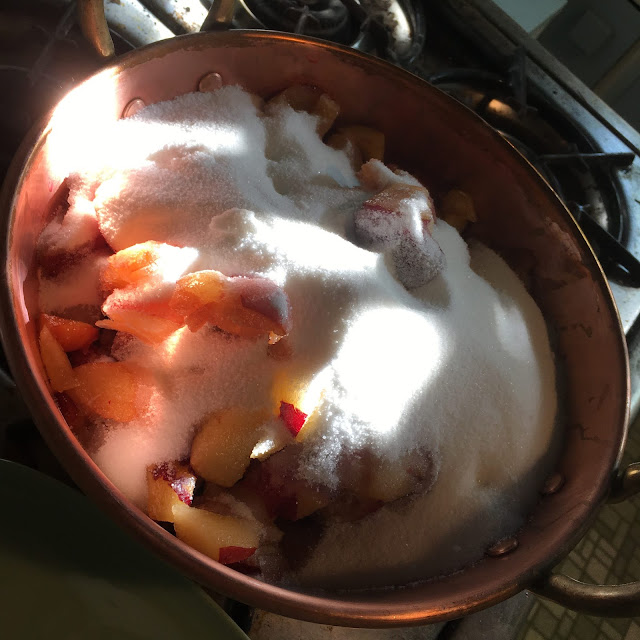Jamboree
We've reached the time in the year when our pluot tree is at its peak, and when I'm making loads of jam. I thought I'd write down all the improvements I've made to my recipe, so that I won't have to rely on memory this time next year.
The basic recipe is five pounds of fruit (with the pits removed), four pounds (eight cups) of sugar, and five or six lemons. This produces between between ten and twelve half-pint jars of jam.
Every morning, I collect the windfall pluots. I wash them and cut off any bruised or damaged sections. Then I cut out the pit and put them in a sealed bag in the freezer. A gallon bag holds about five pounds of fruit, which works out perfectly.
I don't add any liquid, although I might add a few un-frozen pluots, just to get the juices flowing in the pan. It's a bit shocking to see how much sugar goes into making jam.
While the fruit is cooking down, I wash the jars and put the jars and lids in a boiling water bath. I sterilize the lids in a smaller saucepan, for easier handling. I prepare my work surfaces, placing serving plates next to where I'm cooking my jam. My goal is to minimize the mess that I have to clean up at the end of the process. It's much easier to wash a couple of plates than a jam-encrusted stove.
After this, it's just a matter of watching the jam, to make sure that it doesn't scorch on the bottom of the pot, or boil all over the stove. When the jam reaches 219 degrees Fahrenheit, the ratio of sugars to water should be ideal for gelling.
At this point, I juice (and then strain) five lemons, and add their liquid to the jam. This drops the temperature. While the jam is heating back up to 219, I drain the jars and lids, and set up my jar filling station. Just before filling the jars, I skim off any foam that has formed on top of the jam. This foam is actually delicious, but should't be included in jars of jam.
The sealed jars go back in the boil water bath for twenty minutes, and then are set on a cooling rack on the counter. I get a delightful thrill when I hear the jars make the sound that indicates they're properly sealed.
I had intended to write this post for the Monday Harvest blog round-up, but work far from home, and the weekly zoom party that I host meant that I'm posting this a bit late.
If you're interested in reading what other gardeners are doing with their harvests, check out the links, here.







Comments
Have a wonderful day!